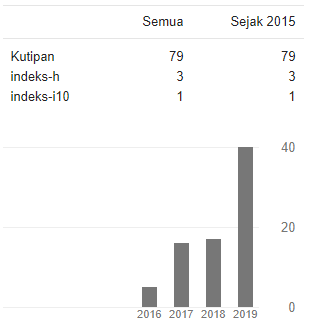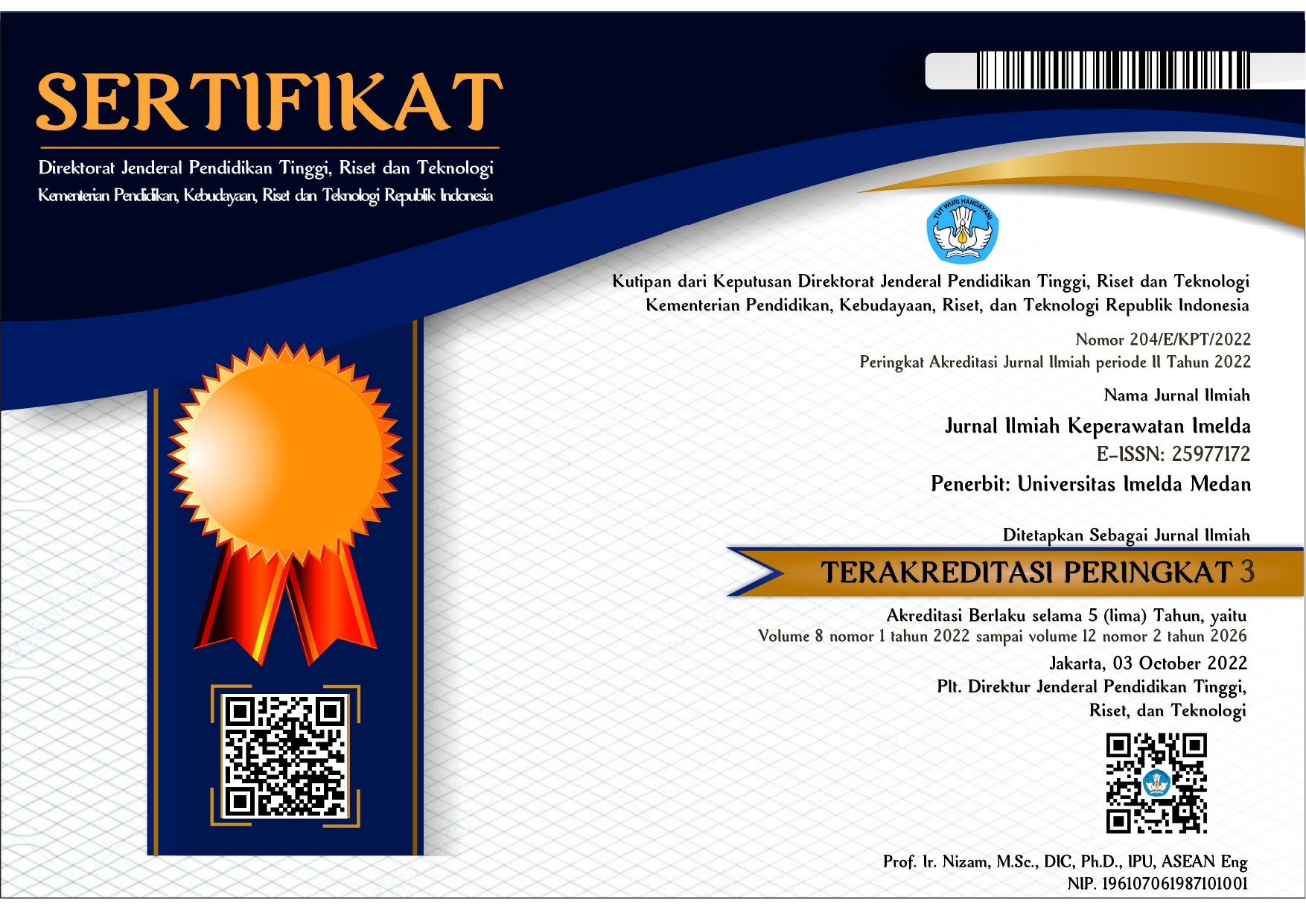STUDI KASUS: ASUHAN KEPERAWATAN PADA PASIEN DENGAN ASFIKSIA NEONATORUM
DOI:
https://doi.org/10.52943/jikeperawatan.v7i2.633Kata Kunci:
Asuhan keperawatan, pasien, asfiksia neonatorumAbstrak
Latar Belakang; Asfiksia neonatorum adalah keadaan dimana bayi tidak dapat bernapas secara spontan dan teratur setelah lahir, disebabkan oleh hipoksia janin dalam uterus. Tujuan: penelitian ini bertujuan untuk mengetahui asuhan keperawatan pada pasien dengan asfiksia neonatorum. Metode: penelitian ini menggunakan metode deskriptif dengan pendekatan melalui pengelolaan asuhan keperawatan pada By R usia 0 hari. Hasil: penelitian ini dilakukan di Rumah Sakit Tentara TK IV 010701 Pematangsiantar pada bulan April 2021. Pengumpulan data dilakukan melalui wawancara dengan keluarga pasien dan perawat. Berdasarkan pengkajian diperoleh data bayi sesak frekuensi 68x/menit, apgar score 5/6, irama nafas irregular, adanya retraksi dada, menggunakan otot bantu pernafasan, mata dan kulit kekuningan, urin kuning pekat, feces berwarna pucat, suhu tubuh 37,5 ºC, peningkatan nilai bilirubin dan leukosit. Setelah dilakukan tindakan keperawatan selama 4 hari seluruh masalah teratasi. Kesimpulan: Implementasi yang dilakukan sesuai dengan rencana yang disusun sehingga ketiga masalah keperawatan dapat teratasi.
Unduhan
Referensi
Farahdiba, I., & Rahmat, B. (2017). Faktor-faktor yang berhubungan terjadinya asfiksia pada bayi baru lahir di Rumah Sakit Syech Yusuf Gowa Tahun 2017. Jurnal Kesehata Delima Pelamonia, 1(2), 185–192.
Fida., & Maya. (2014) Pengantar Ilmu Kesehatan Anak. D-Medika: Yogyakarta.
Gebregziabher, G. T., Hadgu, F. B., & Abebe, H. T. (2020). Prevalence and associated factors of perinatal asphyxia in neonates admitted to ayder comprehensive specialized hospital, Northern Ethiopia: a cross-sectional study. International Journal of Pediatrics.
Kemenkes. (2019). Keputusan Menteri Kesehatan Republik Indonesia No 214. Diakses pada https://yankes.kemkes.go.id.
Lumatauw, S., Kumaat, L. T., & Karundeng, M. (2014). Hubungan pengetahuan dan sikap perawat dengan penanganan asfiksia berat pada bayi baru lahir Di Ruang Nicu Rsup Prof Dr RD Kandou Manado. Jurnal Keperawatan. 2(2).
Mulyati, M., Iswati, N., & Wirastri, U. (2019). Analisis Asuhan Keperawatan pada Pasien Neonatus dengan Hiperbilirubinemia di RSUD Prof. dr. Margono Soekarjo Purwokerto. Proceeding of The URECOL, 203–212.
Notoatmodjo, H., & Rakhmawatie, M. D. (2012). Faktor-Faktor Yang Berhubungan Dengan Kejadian Asfiksia Neonatorum. Jurnal Kedokteran Muhammadiyah, 1(2).
Nursalam, D. (2014). Manajemen Keperawatan" Aplikasi dalam Praktik Keperawatan Profesional. Salemba Medika.
PPNI, Tim Pokja SDKI D P P. (2017). Standar diagnosis keperawatan indonesia.
PPNI, Tim Pokja SIKI D P P. (2018). Standar intervensi keperawatan indonesia.
Pratama, R. T. B. (n.d.). (2018). Asuhan keperawatan pada By. M dan By. L pasca asfiksia neonatorum dengan masalah keperawatan Ketidakefektifan pola nafas di Ruang perinatologi RSUD Dr. Haryoto Lumajang Tahun 2018.
Profil Kesehatan, (2018) Provinsi Sumatera Utara 2018. Dibuka pada website http: kemenkes.go.id. Dibuka pada 1 Maret 2021.
Puspita, N. (2018). The Effect of Low Birthweight on the Incidence of Neonatal Jaundice in Sidoarjo. Jurnal Berkala Epidemiologi, 6(2), 174. https://doi.org/10.20473/jbe.v6i22018.174-181.
Putri, N. N. B. K. A. (2019). Analisis faktor penyebab kejadian asfiksia pada bayi baru lahir di RS Aura Syifa Kabupaten Kediri. Jurnal Ners Dan Kebidanan (Journal of Ners and Midwifery), 6(2), 251–262.
Rahmawati, R. (2019). Faktor-faktor risiko yang berhubungan dengan kejadian asfiksia neonatorum (Studi di RSUD dr. Soekardjo Kota Tasikmalaya Tahun 2019). Universitas Siliwangi.
Sa’danoer, I. M. (2020). Faktor yang Berhubungan dengan Kejadian Asfiksia Neonatorum di RSUD Pariaman. Jurnal Bidan Komunitas, 3(3), 93–98.
Saptanto, A., & Anggraheny, H. D. (2014). Faktor Risiko yang Mempengaruhi Kematian Bayi Asfiksi. Jurnal Kedokteran Muhammadiyah, 3(1).
Shiferaw, W. S., Akalu, T. Y., Wubetu, A. D., & Aynalem, Y. A. (2020). Implementation of Nursing Process and Its Association with Working Environment and Knowledge in Ethiopia: A Systematic Review and Meta-Analysis. Nursing Research and Practice, 2020.
Tampubolon, I. K. (2019). Angka kejadian asfiksia pada bayi Berat Badan Lahir Rendah (BBLR) di Rumah Sakit Umum Pusat Haji Adam Malik.
Utami, R. P. (2019). Faktor-faktor yang berhubungan dengan kejadian asfiksia neonatorum di Rumah Sakit Umum daerah H. Abdul Manan Simatupang Kabupaten Asahan tahun 2017.
Yanti, J. S. (2017). Hubungan hipertensi kehamilan dengan asfiksia neonatorum di RSUD Arifin Achmad. Menara Ilmu, 11(76).
Yulia Sari, D. (2020). Asuhan Keperawatan pasien dengan gangguan kebutuhan oksigenasi pada kasus pneumoni terhadap By R DI Ruang Neonatus RSUD Mayjend HM Ryacudu Kotabumi Lampung Utara. Poltekkes Tanjungkarang.









